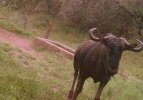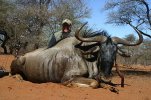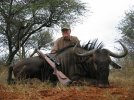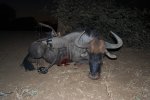The Blue Wildebeest is certainly one of Africa's most well known and popular trophies for many sport hunters.
When giving Blue Wildebeest horn measurement here, I refer to horn length for a Blue Wildebeest which is taking the measurement of the outside spread of the horns from the tip of one horn moving down the outside of that horn following along the curl and up to the base then continue straight across the forehead and follow the same path all the way up to the tip of the second horn (see picture below). This is the method used by the SCI, for more information on
How To Measure Your Trophies you can read AfricaHunting.com article by clicking
here.
Based on SCI method of measurement.
Rowland Ward Methods Of Measurement uses Method 12 for horns of Blue Wildebeest (Brindled Gnu).
Safari Club International Methods Of Measurement uses Method 5 for horns of Common wildebeest and takin.
The name Blue Wildebeest is derived from the conspicuous silvery blue sheen coat of this short haired animal. Another common term for the Wildebeest is Brindled Gnu, Black-Tailed Gnu, Gnu or Gnou, pronounced 'gnew'. It has a couple of nicknames as well, "fool of the veld" or "poor man's Buffalo".
I should say that being able to judge Blue Wildebeest trophy size, quality and maturity is not so difficult. Ultimately judging this species can truly only be done properly from a frontal view as one can only assess the spread, circumference of the base of the horns, depth of curl and shape of the horns from this angle.
01. As you can see here, judging Blue Wildebeest trophy size
from the side is not recommended as one cannot truly assess
the spread, mass and shape of the horns.
Blue Wildebeest have heavy appearance, a beefy muscular front slanting back toward a smaller hindquarter, with a distinctive robust muzzle. Both male and female carry horns shaped like parentheses, extending outward to the side and then curving up and inward, very similar to a Cape Buffalo, but of course smaller. The horns of the Wildebeest will usually not meet or fuse together. While the female's horns are usually smaller than of the male, horns of both sexes are without ridges.
Even when fully mature, it is not always easy to distinguish between the sexes from a distance because there are no striking or identifiable features like horns, body size or color to truly set the sexes apart. The easiest method for sex determination is to use a process of elimination along with experience.
The adult's hue actually varies from a deep slate or bluish gray all the way to light gray or even grayish-brown. The back end coat color is usually slightly lighter in hue than the front and underparts of this animal. Darker vertical bands of slightly longer hair mark the neck and forequarters, and from a distance lend a perception of skin wrinkling. The mane of both sexes appears long, stiff, thick and jet black, a colour found also in the tail and face. Males usually display decidedly darker coloration than the females, however old cows can be as dark as old bulls, with just as many black stripes.
02. From a distance, you can see that the female (right) is
strikingly similar to the bull (left). Body size can easily be seen
here, however, if not side by side, it might not be so obvious to
distinguish that the mature male's bodies are somewhat heavier,
larger, with more muscular shoulders and necks compared to
mature females.
Both male and female Wildebeest are brownish on the forehead when young and their horns are more cow-like. The horns of mature cows are not as thick or widespread as those of trophy bulls and are usually positioned well above the ears.
03. Here is a mature Wildebeest cow that displays thinner,
narrower horns that stand above the ears.
04. Both male and female young Blue Wildebeest are born with
a tawny brown coat which begins to take on their adult
coloration in the first few months of age, notice the cow-like
horns of this young Wildebeest.
05. Notice the typical cow-like horns on the three young Blue
Wildebeest (left) and the brownish v-shaped mark on all of
them including the breeding female (right).
While mature cows will retain a brownish v-shaped mark on their forehead stretching from the base of the ears to between the eyes, on mature bulls this brownish v-shaped mark will usually become obscured as the bull darkens with age. However this is not always a reliable way to judge the maturity of a male as some fully mature males can retain some of the brownish v-shaped mark.
06. Even though much darker, here is a mature male that still
displays the brownish v-shaped mark on it's forehead.
07. Notice the v-shaped mark on the forehead of both of the
Wildebeest above, usually a sign of youth however it can still be
found on mature Wildebeest bulls.
08. Here is an old Wildebeest cow that displays as dark of a coat
as an old bull with just as many black stripes, however notice
the thinner horns standing well above the ears, a good
indication that it is a cow.
Males exhibit rivalry when staking out territory and when competing for females. In the actual clashes between males, they face off resting on bent front knees, exchanging horn thrusts for brief periods. Elaborate individual displays are made in the rivalry and courtship process, where males bellow, snort and grind their horns into the soil.
09. Classic behavior from Blue Wildebeest bulls challenging
each other.
Blue Wildebeest usually have well matched symmetrical horns, although the spread of the horns can vary greatly, from a narrow spread to a prominent spread and a shallower curl to a deeper curl. Most often a prominent spread set of Blue Wildebeest horns will look a lot more impressive. However the type of spread or curl you prefer for your Blue Wildebeest trophy is a matter of personal preference, many hunters really look for the more prominent spread of horns which correlates a lot with the size of the trophy.
On mature bulls the penis sheath is small, hard to see and testicles tucked under. Spread, curl, circumference of the base of the horns and thickness of horns and body development will reliably set sexes apart.
10. Penis sheath can be difficult to see. One would guess by the
size, body strength and coloring of these two bulls that the
older bull is facing to the left.
While judging Blue Wildebeest trophy size, my recommendation would be to first start observing at the overall look of the horns. There are several factors that need to be taken into account in judging the horns of the Blue Wildebeest. A combination of spread of the horns, horn bases known as the boss, depth of the curl, length of the points and thickness of the horns are the key to an amazing trophy.
Based on SCI method of measurement.
Probably the first thing that hunters are conditioned to look at and assess is the straight out length of the spread of the horns when the Wildebeest is looking directly at you, basically checking to see if the horns reach the end of the tip of the ears before hooking up and back. By comparing the outside horns spread to the tip of the ears, gives a first hand gauge as to the size of the trophy. If the straight outside spread of the horns reaches the tips of the ears, the straight outside spread measurement should be bigger than 24 inches (60.96 cm) and can be considered a good starting point for a mature trophy animal. The farther the horns pass the tip of the ears, the better the trophy bull will be. A straight outside spread measurement greater than 27 inches (60.96 cm) makes for a great trophy.


11. When talking about straight outside horn spread in relation
to the tip to tip ear measurement, it is referred to the animal
looking at you with the ears positioned as shown in the above
two pictures. As you can observe from the two Wildebeest bull
above, coat coloration can vary quite a bit. You can also notice
the characteristics of a more mature, developed and aged face
on the bull above.
Through the following pictures you will be able to see the many different shapes of horns that Blue Wildebeest carry, as well as the different variation in color from the head to the body.
12. Here is an amazing trophy, this Wildebeest has an incredible
spread, the bases of the horns do not have the pronounced
bump that is sometimes seen although they are very good in
circumference.
outside spread horns 61.81 inch (157 cm) -
left base 14.17 inch (36 cm) - right base 14.17 inch (36 cm)
13. A good spread on this Wildebeest, the horns pass the tip of
the ears.
outside spread horns 57.09 inch (145 cm) -
left base 14.17 inch (36 cm) - right base 14.57 inch (37 cm)
14. A good spread on this Wildebeest, the horns pass the tip of
the ears.
outside spread horns 53.15 inch (135 cm)
- left base 14.17 inch (36 cm) - right base 14.17 inch (36 cm)
The horns of the Blue Wildebeest will usually not meet or fuse together, however the size of the gap between the two horns is a good indication as to the circumference of the bases. The smaller the gap between the two horns the greater the measurement of the bases circumference will be and how much the circumference of the bases will make a big difference in the total measurement of the overall trophy, often adding several inches for a trophy with bigger bases. Note that the pronounced bump, also known as the boss, sometime seen at the bases of the horns is not a reliable indication of the circumference of the bases themselves. Bases of a good Wildebeest will have a circumference of 12 inches (30.48 cm) to 14 inches (35.56 cm).
15. outside spread horns 57.09 inch (145 cm) -
left base 15.75 inch (40 cm) - right base 15.75 inch (40 cm)
16. These two Wildebeest are very similar in overall size,
spread, shape of horns, depth of curl, length of point, volume of
boss however the one noticeable difference as you can see is
the gap between the horns of this two animals. The Wildebeest
at the top has much less of a gap between the horns which is an
indication of the greater circumference measurement of his
bases compared to the lower Wildebeest.
outside spread horns 59.85 inch (152 cm) -
left base 13.78 inch (35 cm) - right base 13.78 inch (35 cm)
The depth of the curls of the horns on a Blue Wildebeest will have only a bit of an impact on the overall size of the trophy. Some animals will have no depth of curl in their horns making their horns appear to shoot straight out, looking almost flat. This does not mean that the Wildebeest will not measure well, though it usually is a sign of lesser measurement in the spread of the horns. It is a different shape of horns which does not necessarily mean that the animal is immature.
17. This old bull's horns have a more flat look and the low
measurements reflects just that.
outside spread horns 50.79 inch (129 cm) -
left base 13 inch (33 cm) - right base 13.38 inch (34 cm)
18. Though thicker, this old bull's horns have no depth of curl,
to the contrary the horns are positioned well above the ears and
very much resemble those of a Blue Wildebeest cow or young
bull. The measurement of the outside spread of the horns is not
impressive though this is still a good trophy bull past it's prime.
outside spread horns 47.24 inch (120 cm) -
left base 14.17 inch (36 cm) - right base 14.57 inch (37 cm)
19. Notice the prominent jet black coloration in the face and
dark vertical bands on the forequarters a good sign of maturity.
outside spread horns 50.40 inch (128 cm) -
left base 10.83 inch (27.5 cm) - right base 11.81 inch (30 cm)
20. The bulging bases, or boss, of this old Wildebeest are quite
prominent giving the appearance of more depth of curl, a
genetic characteristic that may be found more prominently in
some parts of Africa than others.
On a personal note an amazing Blue Wildebeest trophy is not necessarily just about horn size, but also in the character of an old Blue Wildebeest Bull. The Blue Wildebeest trophy can also be found in the qualities of age that can be seen in the cape of the animal especially if shoulder mounted. A great colored cape with lots of contrast along with a good mane and beard are features that are part of an amazing trophy.
I included numbers for each picture if anyone wanted to comment or refer to an image...
Note that trophy size can differ from region to region and what may easily be found in one area may be unexpectedly large in another. As with most animals there is always localities where the bigger trophies tend to be found.















